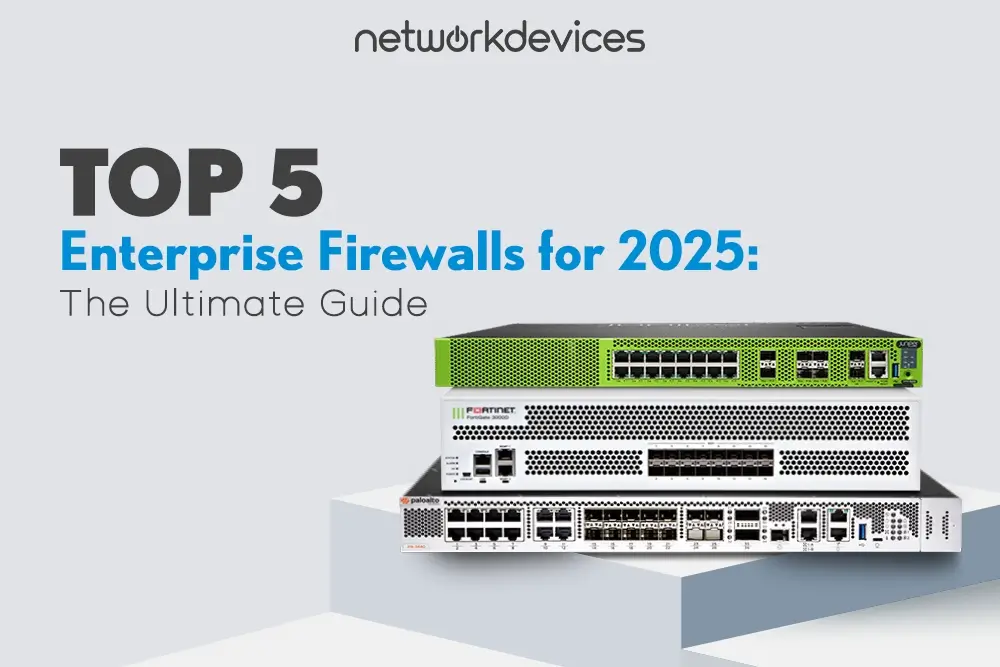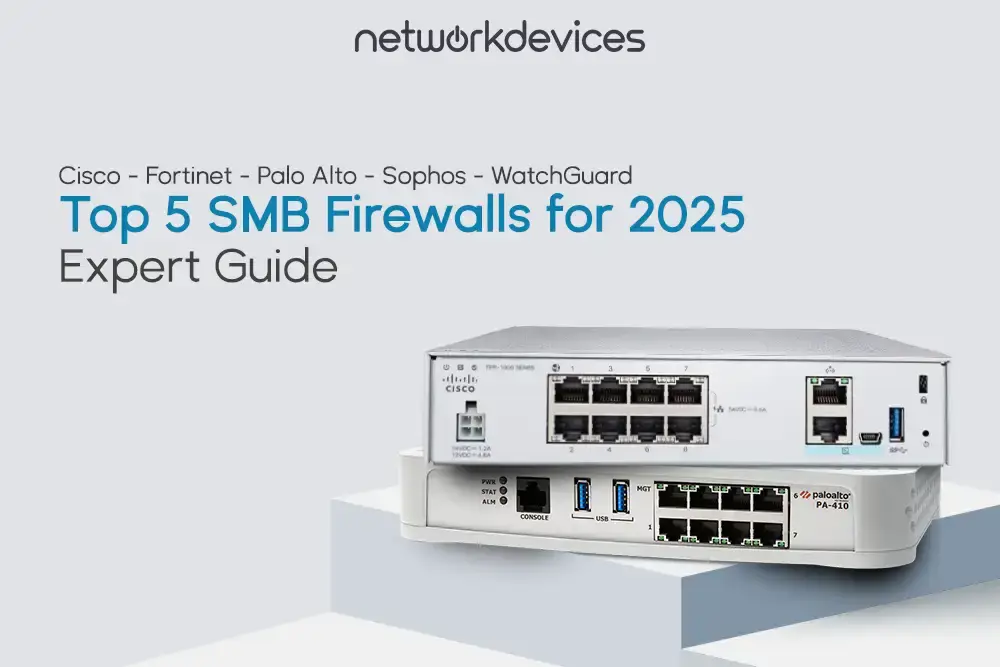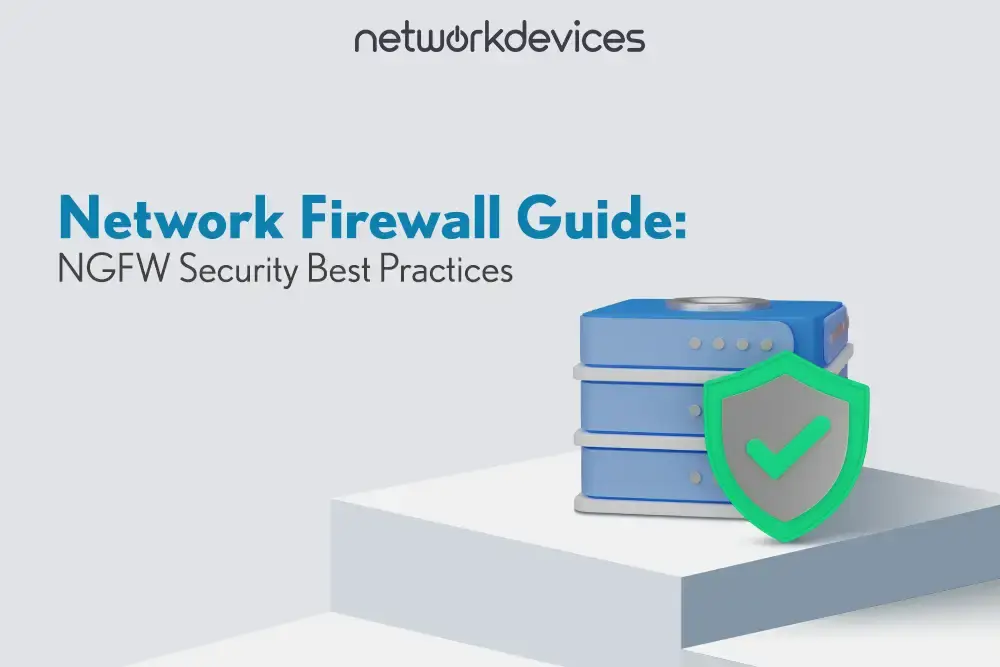Executive Summary
Enterprise firewalls serve as the cornerstone of network security, protecting organizations from increasingly sophisticated cyber threats.
This comprehensive guide evaluates the best enterprise firewall solutions for 2025, analyzing their performance capabilities, threat prevention features, and integration options.
We'll examine how next-generation firewalls (NGFWs) implement advanced technologies like AI-powered threat detection, zero-trust architecture, and cloud security integration.
Our expert recommendations will help security leaders make informed decisions when selecting enterprise firewall solutions that balance protection, performance, and compliance requirements.
Introduction
Cyber threats are growing increasingly sophisticated, forcing businesses to adopt robust security measures to protect their networks, applications, and sensitive data.
Enterprise firewalls serve as the critical first line of defense in this ongoing battle against evolving cybersecurity challenges.
Modern enterprise firewalls go far beyond simple traffic filtering. They now incorporate intrusion prevention systems, advanced threat intelligence, and machine learning capabilities.
This comprehensive guide explores the key factors to consider when selecting an enterprise-grade firewall. We'll reveal our top five recommendations for 2025, helping you navigate the complex cybersecurity landscape with confidence.
Emerging Trends in Enterprise Firewall Technology
The enterprise firewall market is evolving rapidly to meet new security challenges. Understanding these trends will help you make a future-proof investment in your network security infrastructure.
Let's explore the key developments shaping enterprise firewall solutions in 2025 and beyond.
SASE Enterprise Firewall Solutions
Secure Access Service Edge (SASE) combines network security functions with WAN capabilities to support secure access from any location. This architectural approach is revolutionizing enterprise network security.
Key SASE Components
SASE integration with enterprise firewalls includes several critical elements:
- Firewall as a Service (FWaaS): Cloud-delivered firewall security without hardware dependencies
- Zero Trust Network Access (ZTNA): Continuous verification of users and devices before granting resource access
Cloud Security Integration
SASE also enhances cloud protection capabilities:
- Cloud-native Security: Consistent security policy enforcement across on-premises, hybrid, and multi-cloud environments
- Secure Web Gateway (SWG): Protection against web-based threats while ensuring compliance with security regulations
Leading providers like Palo Alto Networks and Fortinet have already integrated SASE capabilities with their enterprise firewall offerings, providing centralized cloud security management for distributed networks.
AI for Enterprise Firewalls: Advanced Threat Prevention
Artificial intelligence and machine learning are transforming how enterprise firewalls identify and respond to threats in real time. These technologies dramatically improve protection against sophisticated attacks.
Behavioral Detection Systems
Modern AI systems go beyond traditional signature-based detection:
- Behavioral Analytics: Identifies anomalies in traffic patterns to detect zero-day threats before they can cause damage
- Automated Threat Response: AI-driven systems that can isolate infected endpoints without manual intervention
Enhanced Inspection Capabilities
AI also improves traditional security functions:
- Enhanced Deep Packet Inspection (DPI): Machine learning algorithms improve inspection accuracy for better malware detection
- Predictive Threat Intelligence: AI models that forecast potential attack vectors based on global threat data
Check Point's Quantum Security Gateway exemplifies this trend, using AI-powered Sandblast technology to detect and prevent zero-day attacks and advanced persistent threats (APTs) with remarkable accuracy.
Quantum-Safe Firewalls for Enterprises
With quantum computing on the horizon, enterprise firewall vendors are preparing for the cryptographic challenges this technology will bring to network security protocols.
Traditional encryption methods could become vulnerable once quantum computers reach sufficient processing power.
Forward-thinking enterprise firewall solutions now offer multiple layers of protection:
- Post-quantum encryption support: Integration of cryptographic algorithms designed to withstand quantum computer attacks
- Quantum-proof data encryption: Next-generation encryption methods that safeguard sensitive data against future quantum-based cryptographic attacks
- Cryptographic agility frameworks: Allowing rapid transition between encryption algorithms as quantum threats evolve
Industry leaders Cisco and Juniper Networks are leading the way in developing quantum-safe cryptographic solutions for their enterprise firewall products.
These innovations ensure long-term data protection even as computing capabilities advance dramatically in the coming years.
XDR and Enterprise Firewalls: Unified Security
Enterprise firewalls are increasingly becoming integral components of broader Extended Detection and Response (XDR) platforms, enhancing intrusion detection capabilities and overall vulnerability management.
This strategic convergence combines firewall security with:
- Security Information & Event Management (SIEM): Centralized security monitoring and alert correlation
- Security Orchestration, Automation, and Response (SOAR): Automated workflows for threat response
- Endpoint Detection & Response (EDR): Correlation of firewall alerts with endpoint security data for comprehensive protection
- Network Traffic Analysis (NTA): Advanced behavioral analytics across all network communications
Cisco Firepower's integration with SecureX demonstrates this trend, creating a unified security ecosystem that enhances threat visibility and response capabilities across the entire attack surface.
5G Network Firewalls for Enterprises
Expanding 5G networks and edge computing create new security challenges that modern enterprise firewalls must address through enhanced remote access security and advanced network segmentation.
Key developments in this area include:
- High-bandwidth throughput: Supporting faster, lower-latency network connections without sacrificing inspection depth
- Decentralized security architecture: Protecting data at edge locations rather than just in central data centers
- Edge-focused micro-segmentation: Enforcing granular security policies closer to users and devices
- IoT-specific protection: Specialized security controls for the proliferation of connected devices
Fortinet's Frigate series exemplifies this trend with its Secure SD-WAN capabilities designed to protect distributed edge locations from emerging cyber threats while maintaining enterprise firewall performance across high-speed 5G connections.
Zero Trust Enterprise Firewalls
Zero Trust Architecture (ZTA) has become essential for modern network security, and enterprise firewalls are evolving to support these comprehensive security models through advanced integration capabilities.
Zero Trust enterprise firewalls implement:
- Identity-based access controls: Ensuring only authenticated users and devices can access network resources
- Micro-segmentation capabilities: Limiting lateral movement of threats within corporate networks through granular firewall policies
- Continuous monitoring systems: Adjusting security policies based on real-time risk assessments
- Least-privilege access enforcement: Restricting permissions to the minimum needed for each user or application
Palo Alto Networks has been a pioneer in this space, implementing Zero Trust principles through micro-segmentation and identity-driven security policies in their enterprise firewall solutions, minimizing the attack surface across hybrid environments.
Automated Compliance and Regulatory Controls
With increasingly strict data privacy regulations (GDPR, CCPA, HIPAA, PCI-DSS), enterprise firewalls are enhancing their compliance capabilities:
- Automated compliance reporting: Streamlining log collection and audit processes
- Customizable security policies: Adapting firewall rules to specific regulatory requirements
- Real-time compliance monitoring: Identifying potential violations before they lead to penalties
Check Point's compliance posture management features exemplify this trend, helping ensure enterprise networks remain audit-ready at all times.
Advanced Automation and Orchestration
As networks grow more complex and security alerts multiply, manual firewall management becomes impractical. Key automation developments include:
Cross-Platform Security Integration
Modern enterprise firewalls need to work within broader security ecosystems:
- Cross-platform integrations: Enabling firewalls to participate in automated security frameworks
- Security workflow automation: Streamlining routine security operations across multiple platforms
Intelligent Policy Management
AI improves the management of complex firewall environments:
- ML-driven policy adjustments: Using machine learning to dynamically update firewall policies based on evolving threats
- Policy optimization: Identifying and resolving redundant or conflicting security rules
Automated Remediation
Advanced orchestration enables rapid response to security incidents:
- Self-healing network capabilities: Automating threat blocking, vulnerability remediation, and system recovery
- Automated incident response: Coordinating actions across multiple security systems
Security Democratization
Making complex security more accessible:
- Low-code security automation: Empowering security teams to create custom workflows without deep coding expertise
- Pre-built security playbooks: Implementing industry best practices with minimal configuration
How to Choose an Enterprise Firewall: Key Selection Criteria
Enterprise firewalls differ significantly from SMB solutions. They're engineered for large-scale, high-performance networks that require robust network security, seamless cloud integration, and centralized management.
When evaluating enterprise firewall solutions for your organization, consider these critical factors that will impact your security posture and operational efficiency.
1. Enterprise Firewall Performance and Scalability
Enterprise networks process massive volumes of traffic across multiple locations. Your network firewall must deliver high throughput and low latency while scaling with business growth.
Essential performance metrics to evaluate include throughput capacity (Gbps) - the volume of data a firewall can process per second.
You'll also need to assess concurrent sessions - the number of simultaneous connections the firewall can maintain. Additional critical performance factors include:
- Packet processing rate (PPS): How quickly the firewall inspects and processes network packets
- TLS/SSL inspection performance: Decryption and inspection capabilities without significantly impacting throughput
- Latency impact: The delay introduced by firewall inspection processes
- New session establishment rate: How many new connections can be created per second
- Maximum policy capacity: The total number of firewall policies the system can enforce without performance degradation
Networks supporting hybrid cloud infrastructures particularly need enterprise firewalls capable of handling terabit-scale throughput without performance bottlenecks.
This is especially important when implementing deep packet inspection across all traffic.
2. Advanced Threat Protection for Enterprise Networks
Enterprise networks face constant threats from malware, ransomware, and Advanced Persistent Threats (APTs). Your next-generation firewall (NGFW) should include comprehensive threat prevention capabilities:
- Sophisticated intrusion prevention systems (IPS) with real-time signature and behavioral analysis
- Deep packet inspection (DPI) technology for thorough content examination
- AI-powered threat intelligence feeds with global threat correlation
- Zero-day threat protection through advanced heuristic analysis
- Zero Trust security model support with continuous authentication
- Integrated antivirus and anti-malware protection for multi-layered defense
Next-generation firewalls leveraging AI and behavior-based detection algorithms provide superior defense against sophisticated cyber threats that might evade traditional signature-based systems, particularly for protecting against ransomware and fileless malware attacks.
3. Multi-Cloud Security and Hybrid Cloud Security
Today's enterprises operate in diverse cloud environments, requiring cloud-based enterprise firewall solutions that protect workloads across multiple platforms.
Your firewall architecture should offer seamless integration with major cloud platforms, including AWS, Azure, and Google Cloud.
Consistent policy enforcement across on-premises and cloud networks is essential for maintaining security standards. Additional requirements include:
- Secure SD-WAN connectivity for distributed locations
- Cloud-native security controls for containerized applications
- Centralized visibility across multi-cloud deployments
Flexible, cloud-friendly enterprise firewalls enable IT teams to maintain unified security policies across increasingly distributed infrastructure landscapes.
This approach ensures strong protection against cloud-specific vulnerabilities and misconfigurations that could otherwise expose critical assets.
4. Enterprise Firewall Management and Orchestration
Managing enterprise firewall security across multiple locations presents significant complexity. Look for solutions offering:
- Centralized management dashboards for unified policy control
- Automation capabilities for routine security tasks and vulnerability management
- Orchestration tools for coordinating security responses across platforms
- AI-driven analytics for real-time threat detection and response
- Comprehensive reporting tools for compliance and security posture assessment
- Policy optimization features that identify redundant or conflicting rules
Enterprise firewalls with robust automation and orchestration features reduce administrative overhead while enhancing security effectiveness through consistent policy enforcement and faster incident response times.
Enterprise Firewall Hardware Considerations
Beyond software capabilities, enterprise-grade firewalls must offer specific hardware features to ensure reliability, scalability, and high availability in demanding environments.
Modular Architecture for Future Growth
- Flexible hardware design allows businesses to upgrade processing power, network interfaces, or storage without complete system replacements.t
- Hot-swappable components minimize downtime during hardware expansions or replacemen.ts
- Multiple expansion slots accommodate additional security processors, VPN accelerators, or high-speed network interfaces (100/400 Gbps)
Redundant Components for High Availability
- Dual supervisor modules ensure continuous operation if primary management components fail.
- Stateful failover capabilities preserve ongoing sessions during hardware failures, preventing user disruptions.
- Multiple power supplies (dual or triple redundant) with hot-swap functionality protect against power-related failures
- Advanced cooling systems (liquid cooling or intelligent fan control) improve energy efficiency in high-performance data centers.
Specialized Security Processing Hardware
- Security Processing Units (SPUs) or Application-Specific Integrated Circuits (ASICs) accelerate packet inspection and encryption processes
- Field-Programmable Gate Arrays (FPGAs) enable custom security functions adaptable to emerging threats
- Hardware-accelerated VPN enhances performance for IPsec and SSL connections without taxing main system resources
Virtual Context Support
Modern enterprise firewalls often support virtualization capabilities:
- Virtual firewall instances allowing a single physical device to be divided into multiple independent virtual firewalls
- Granular resource allocation for connections, policies, and bandwidth across virtual instances
- Multi-tenant environments are ideal for service providers, data centers, and enterprises requiring strict network segmentation
Management and Monitoring Infrastructure
Enterprise firewalls should include:
- Dedicated management ports for secure remote administration
- Built-in logging and monitoring hardware for forensic investigations
- Hardware-based time synchronization (PTP/NTP) for accurate event correlation
Enterprise Firewall Implementation: Selection Process
Selecting the right enterprise firewall solution requires careful planning and evaluation. Follow this structured process to make an informed decision that aligns with your organization's security requirements:
Step 1: Define Your Security Requirements
- Identify which environments need protection (on-premises, cloud, hybrid, remote locations)
- Assess your organization's risk profile based on industry, compliance requirements, and threat landscape
- Document current and anticipated network traffic patterns and volumes
Step 2: Prioritize Advanced Threat Protection
- Evaluate AI-driven security features that provide proactive rather than just reactive protection
- Look for solutions with robust threat intelligence integrations and regular security updates
- Consider behavioral analysis capabilities for detecting sophisticated, unknown threats
Step 3: Calculate Total Cost of Ownership
- Factors in initial purchase costs, licensing fees, subscription costs, and maintenance expenses
- Consider staffing requirements for managing the solution effectively
- Evaluate scalability costs as your organization grows
Step 4: Test Before Deployment
- Conduct proof-of-concept testing with finalist vendors
- Validate performance metrics and compatibility with existing infrastructure
- Test security effectiveness against relevant threat scenarios
Step 5: Plan Migration Strategy
For organizations upgrading existing firewalls:
- Assess current infrastructure to identify security gaps and performance limitations
- Test configurations in isolated environments before production deployment
- Evaluate vendor migration tools and professional services options
- Implement monitoring to validate security effectiveness post-migration
Step 6: Follow Implementation Best Practices
- Develop clear security policies aligned with business requirements
- Follow vendor-recommended deployment guidelines
- Consider professional services for complex implementations
- Establish ongoing maintenance and update procedures
Top 5 Enterprise Firewalls for 2025
Palo Alto Networks continues to lead the enterprise firewall market with its advanced PA-Series models.
These hardware enterprise firewall solutions leverage sophisticated machine learning to detect and block threats in real time.
Key strengths:
- Deep network visibility with application-level inspection
- Industry-leading automated threat prevention and zero-day protection
- Zero-trust segmentation capabilities with advanced network segmentation
Additional capabilities include:
- Seamless integration with hybrid cloud infrastructures
- Superior SSL/TLS inspection performance
Ideal for: Enterprises operating complex multi-cloud environments with stringent security requirements and compliance needs.
Real-World Implementation: Global Financial Institution
A multinational bank successfully deployed PA-Series enterprise firewalls to protect critical financial transactions from sophisticated attacks and advanced persistent threats (APTs).
The implementation enabled them to enforce PCI-DSS compliance requirements with automated compliance reporting. They successfully implemented TLS/SSL decryption for encrypted traffic inspection without performance degradation.
The solution also enabled secure SD-WAN connectivity across global branch locations with consistent policy enforcement.
Fortinet's FortiGate series delivers exceptional enterprise firewall performance for large-scale networks requiring high-speed, AI-enhanced security with advanced threat protection.
Key strengths:
- Custom security processing units (SPUs) for accelerated threat detection and intrusion prevention
- Excellent throughput-to-cost ratio with industry-leading firewall performance
- Integrated Secure SD-WAN capabilities for distributed location protection
- Comprehensive security fabric integration for orchestrated defense
- Advanced malware protection with real-time cloud lookups
Ideal for: Organizations requiring high-performance network security without compromising throughput, especially in environments with high-bandwidth requirements
Real-World Implementation: Healthcare Network
A hospital system implemented Frigate 7000 enterprise firewalls to secure the following:
- Sensitive patient records with HIPAA-compliant controls and automated compliance monitoring
- Connected medical IoT devices against emerging threats through deep packet inspection (DPI)
- Telemedicine services with SSL/TLS inspection and protection against zero-day threats
- Zero-trust network access for clinical systems with continuous authentication and authorization
3. Check Point Quantum Force Series (19000, 29000)
Check Point's Quantum Force delivers industry-leading threat prevention through a powerful combination of AI, machine learning, and deep threat analysis with exceptional ransomware protection.
Key strengths:
- Best-in-class threat prevention capabilities with advanced behavioral analysis
- Centralized enterprise firewall management for complex infrastructures
- Advanced bot protection and IoT security with specialized detection engines
- Comprehensive compliance automation for regulatory requirements (GDPR, CCPA, PCI-DSS)
- Superior threat intelligence integration with global sensor network
Ideal for: Organizations facing sophisticated threats requiring advanced prevention capabilities and in-depth defense against zero-day attacks
Real-World Implementation: E-Commerce Platform
- A major e-commerce company deployed Quantum Force enterprise firewalls to:
- Secure millions of daily transactions against fraud and payment interception attempts
- Implement advanced DDoS protection without performance impact on customer experience
- Automate compliance monitoring for PCI-DSS and GDPR requirements with detailed audit trails
- Establish consistent security policies across multi-cloud environments with unified management
- Deploy deep SSL inspection for encrypted traffic analysis without latency penalties
4. Cisco Firepower Series (4200 & 9300)
Cisco's Firepower continues to excel with robust next-generation firewall (NGFW) capabilities and seamless integration with the broader Cisco security ecosystem, providing comprehensive network firewall protection.
Key strengths:
- Real-time threat detection and response with advanced intrusion prevention
- Integration with SecureX for automated security workflows and orchestration
- Excellent visibility across the entire attack surface with unified monitoring
- Strong performance in high-throughput environments with minimal latency
- Advanced malware protection with continuous analysis capabilities
Ideal for: Organizations with existing Cisco infrastructure seeking unified security management and those requiring enterprise-grade firewall solutions with deep integration capabilities
Real-World Implementation: Government Data Center
A national government agency implemented Cisco Firepower enterprise firewalls to:
- Protect classified data with advanced security controls and multi-layer encryption
- Defend against sophisticated state-sponsored threats and advanced persistent threats (APTs)
- Ensure high availability for critical systems through redundant deployment architecture
- Integrate with existing Cisco infrastructure for unified management and threat correlation
- Implement granular firewall policies based on user, application, and content characteristics
5. Juniper Networks SRX Series (1600, 2300, 4300, 4700, 5000)
Juniper's SRX series provides exceptional enterprise firewall performance for organizations requiring advanced security in high-throughput environments with superior scalability requirements.
Key strengths:
- AI-driven security analytics with behavioral anomaly detection
- Deep network visibility and threat correlation across distributed environments
- Excellent performance-to-price ratio with industry-leading firewall throughput
- Strong multi-cloud protection capabilities and hybrid cloud security features
- Carrier-grade reliability with extensive hardware redundancy
Ideal for: Telecommunications and service providers requiring carrier-grade network security at scale, especially for 5G network firewalls and edge computing deployments
Real-World Implementation: Telecom Provider
A major telecommunications company deployed Juniper SRX enterprise firewalls to:
- Secure terabit-scale network traffic without performance degradation or bottlenecks
- Protect 5G infrastructure and IoT device communications with specialized threat prevention
- Implement AI-powered analytics to detect and mitigate sophisticated DDoS attacks
- Deploy zero-trust security architecture for core network elements with micro-segmentation
- Ensure compliance with telecommunications regulatory requirements through automated reporting
Conclusion
Enterprise firewalls remain the cornerstone of network security, protecting critical infrastructure, data, and applications from increasingly sophisticated cyber threats.
Selecting the right solution depends on your organization's specific infrastructure requirements, compliance needs, and security priorities. A properly configured enterprise firewall solution creates a strong foundation for your overall cybersecurity strategy.
The five enterprise firewall solutions highlighted in this guide represent the leading options for 2025. They offer exceptional security capabilities, scalability, AI-enhanced protection, and seamless cloud integration.
Investing in a robust enterprise firewall solution today means building strong defenses against the cyber threats of tomorrow. As the threat landscape continues to evolve, these advanced security platforms will help ensure your organization stays protected against even the most sophisticated attacks.
For more information about implementing these solutions in your environment, contact us today. We can help you navigate the selection and deployment process for enterprise firewall solutions matching your business requirements.
About the Author: This guide was created by our team of network security professionals, who have over 15 years of experience implementing enterprise-grade security solutions across the financial services, healthcare, government, and telecommunications sectors. Our experts hold advanced certifications in network security, cloud infrastructure, and cybersecurity architecture.







 Deals
Deals






